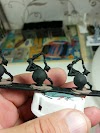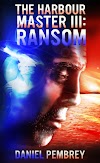This posting has been sitting in the draft for so long it has probably gone cold. It was inspired by another bloggers' ('Ross Mac's') observations of what Brigadier Peter Young - co-author of the classic Charge! - or How to Play War Games - had to say about the application of morale in war games. Check it out.
The Brigadier's view was that as much as possible, the moral effect of close action, the need to take quick decisions and the pressure of losses, should be held in the mind of the player. In my experience, players do respond very differently to the pressures of war games battle. Not only do you get the stoic, the mercurial, the rash, the deliberate, the cautious, the active... you get differences in sensitivity to battle losses, to unexpected events, and to surprise.
In reply to Ross's posting I said: YES!! Brig Young's ideas on morale rules I have shared as long as I have been a war gamer. At that they have been confirmed from observation. It is surprising how many war gamers will give up a fight long before there is any real call to do so. I've even seen the battlefield quit - this in a campaign game - when the army under command was getting the better of it. On occasions when I have been feeling a bit below par, my own stoicism in the face of losses has failed to stand the test.
Associated with this is my adherence to figure removal by way of casualties. Many players are probably unaware of the difference that apparently primitive and unsophisticated game mechanic can make. I know one gamer - beautiful painter of troops - who quite openly admitted to me that he couldn't stand seeing his troops physically whittled away once they got into a fight. This was on the occasion of a refight of the Redinha rearguard action (1811), in which I handled the French. He was making heavy weather of it, despite his skilled handling of the British attackers, bemoaning losses I would have considered fairly trivial - and he was giving as good as he was taking into the bargain. He won the game (well, it was really that kind of scenario: although driven from the field, I was happy to have inflicted as much loss to the British as I took myself, and got my people off in good order), but I formed the impression he found it a harrowing experience.
 |
| A Division in square, forming two Brigade squares. The enemy Attack is expected from the right of the picture... |
Then I foreshadowed elaborating this in a future posting (this one). That was seven or eight weeks ago - not a good look. I hope what I have to say here will have been worth the wait...
In my proposed Big Battles for Small Tables rule set, I believe that something as simple as the Young and Lawford game mechanic is called for, given the organisational building block is the 24-figure Infantry Division, and 12-figure Cavalry Brigade. This went simply: a unit that retains more than 50% of the strength with which it began the battle, may behave normally. This system will apply to my 'unit-formations' - Divisions and Brigades. There will be other occasions in which unit-formations will slip from a commander's control. These will be occasioned by events, and the effects of those will be temporary. Once a unit-formation has reached 50% losses, it suffers for the remainder of the battle from loss of morale - that is to say: its effects are permanent.
 |
| A single Divisional square under heavy attack from Austrian cavalry: dragoons and cuirassiers. |
Having lost morale, such a unit:
1. It said to have 'broken' and, to use Young and Lawford's terminology: is also 'understrength';
2. Must retreat for at least one full move, or into cover outside musketry range of the enemy;
3. Must then spend at least one move, stationary and disordered, rallying;
4. Henceforth are permanently disadvantaged in all fire and close combat (The notions of 'advantage' and 'disadvantage' in combat will be elaborated upon in a future posting on combat mechanics for BB4ST);
5. May be converged with other understrength unit-formations (of the same type, of course; horse with horse, foot with foot), but the moral effects still remain with the converged unit-formation.
This loss of morale is permanent for the duration of the action for understrength units, converged or otherwise. But there will be occasions in which loss of morale will occur to unit-formations not yet understrength, and in consequence will be temporary. This really is more by way of an uncontrolled reaction to adverse events. The sole 'adverse event' that will cause this in war games terms will be this: defeat in close combat.
.jpg) |
| V Army Corps: 17th Division deployed in successive lines, skirmishers out. How will morale and reaction apply to The Division deployed in this way? See next time. |
Close combat in game terms will occur when the skirmishing screens have been driven in, and the unit-formations' main bodies have pressed closer than outer musketry range (tentatively 3" or 7.5cm) into close musketry range (1" - 2.5cm - or less). I say 'less than 1 inch' as players might elect to depict the close combat by bringing the opposing forces into contact. I'm inclined to go with Paddy Griffith on this (Napoleonic Wargames for Fun), and maintain a small gap, depicting not so much a crossing of bayonets as a frantic fire-fight at very close range, or maybe simply the action of both forces, the one by edging closer, the other by standing its ground, in attempting to intimidate the enemy.
Having been defeated, a unit 'breaks' and retires at least one full move rearward, where it must spend a whole further move rallying (I have yet to decide whether this takes place in the same or the following turn. I'm leaning towards the latter at present). The victorious unit-formation may then occupy the ground won, possibly even exploit onto targets further on, or even rally back. Until it has spent a move stationary, that unit remains disordered. Disorder places a unit at a disadvantage in combat until the unit-formation has been rallied....
 |
| IV Army Corps: 11th Division. The pictures in this article foreshadow the topic of the next in this series: Division deployments and how morale and reaction effects will apply to them. |
Acknowledgement:
May I extend my welcome to Follower #110: Vasiliy Levashov. Thanks for joining.










0 Yorumlar